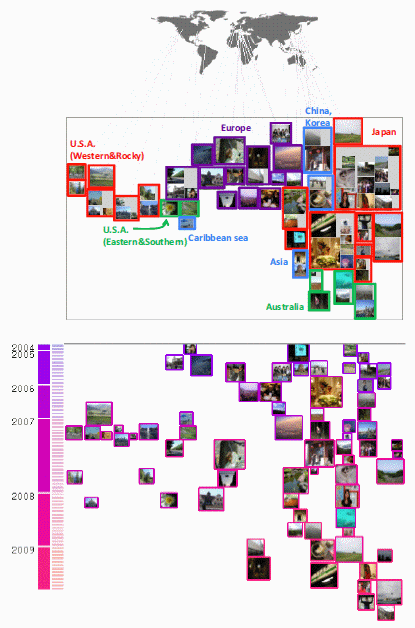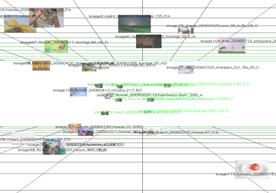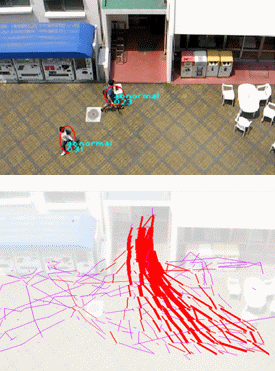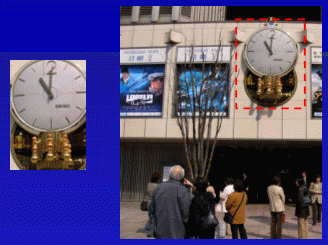As Digital cameras and consumer-produced websites have become common, there are more chances of treating image information systems of photographs and videos. This section introduces the projects of Ito laboratory related to still and moving images.

|
Because digital cameras are in widespread use nowadays, more people take a large amount of photos for pleasure.
In addition, images of perticular fields like medical services, securities, satellites are also tend to be stored in large quantity .
We have been developing a browser which we can look through a great deal of photos at sight.
|
- A. Gomi, R. Miyazaki, T. Itoh, J. Li, CAT: A Hierarchical Image Browser Using a Rectangle Packing Technique, 12th International Conference on Information Visualization (IV08), pp. 82-87, 2008. (PDF)
|
Advancing our research of an image browser, we have considered its purposes for example,
to search for a specific photo from so many personal pictures or to analyse one's life,
treating the photos as a kind of personal history.
|

|
- A. Gomi, T. Itoh, MIAOW: A 3D Image Browser Applying a Location- and Time-Based Hierarchical Data Visualization Technique, Advanced Visual Interface (AVI10), pp. 225-232, 2010.

|
When developing the image browser, we have focused on the point
that lots of meta-information and amount of characteristic can be added.
|
|
To sum up the content of a long-term dynamic picture image, there is a challenge in displaying the result of summarization of the movie, and performing this task is important not only in the research of motion images, but also in the study of visualization. We have set out two types of studies as approaching this issue. The first study is to visualize the digest of human transfer pathway obtained by aerial photographs and sensors. We have proposed the visualization technique named 'FRUITE Route'. This technique can display many pieces of channel information with simplified forms, based on the consept of bundling the similar parts together in a group. The second study is the visualization which summarizes the image with lists, extracting the important frames from the motion-image sequence. We have been developing the motion-image browser which can compare the several motion-image files, aligning the keyframes in a horizontal direction and controlling the level of detail for the purpose. |


|

|
The researches of an automatic recognition of the scene in images and searching its content by computer have been carried out for a few decades. However, there is an increasing need due to the popularization of image search engines.
|
- A. Gomi, T. Itoh, K. Koyamada, S. Hido, VIEWGLE: Fast Extraction of Similar Partial Images for Querying Viewing Parameters, NICOGRAPH International 2006. (PDF)
|
The research on an automatic recognition of images by computer is in progress, not only on still images but also on moving ones.
One of the most well known theme is to perceive the movement or the emotion from a facial image of human.
Many proposed systems estimate these movements or the emotions by detecting the displacement of characteristic points like eyes or mouth. However, it is very difficult to continue tracking the objects without losing the points.
|

|
- Y. Nomura, T. Itoh, Y. Yamaguchi, A Robust Method of Facial Feature Tracking for Moving Images, NICOGRAPH International 2007. (PDF)